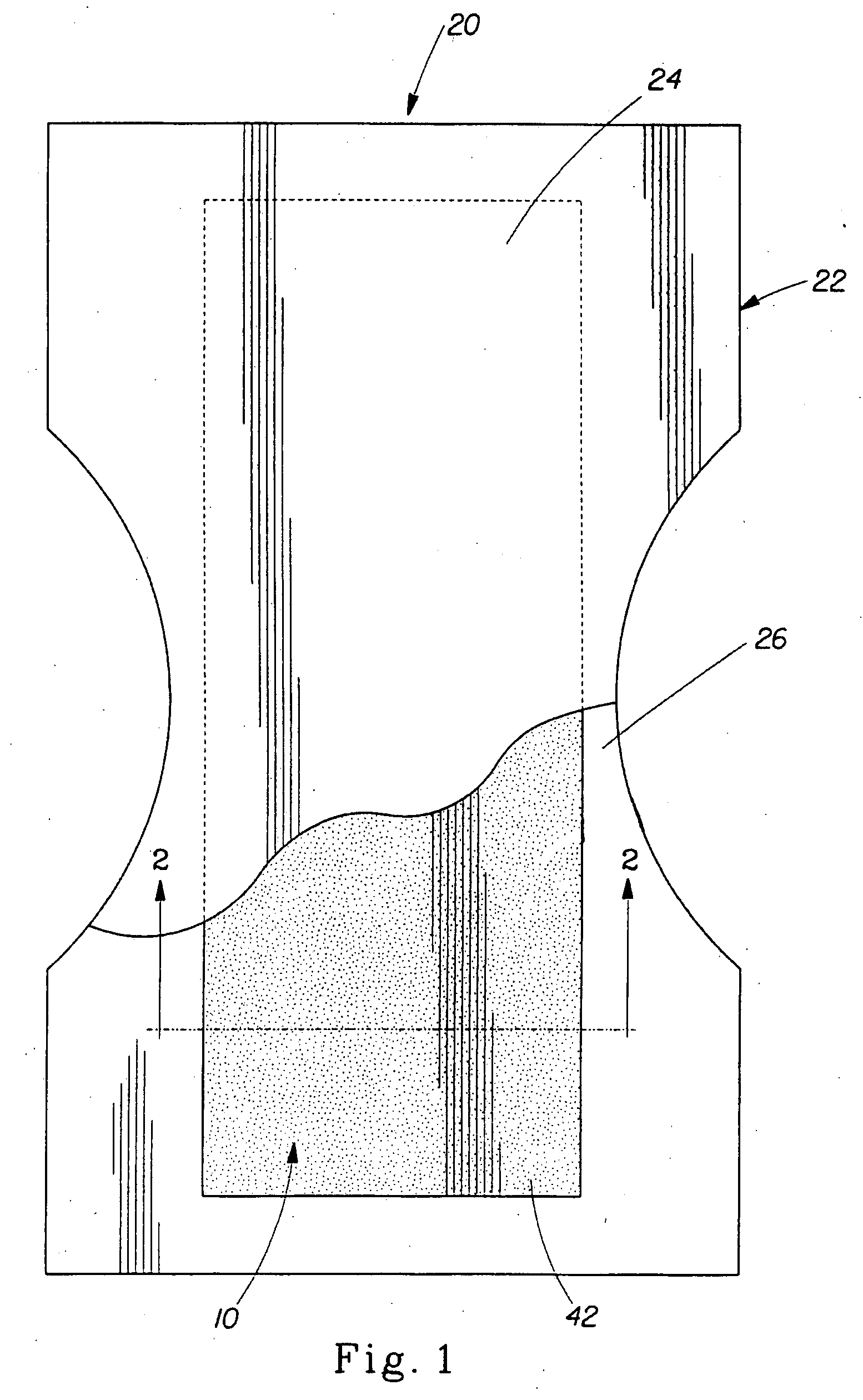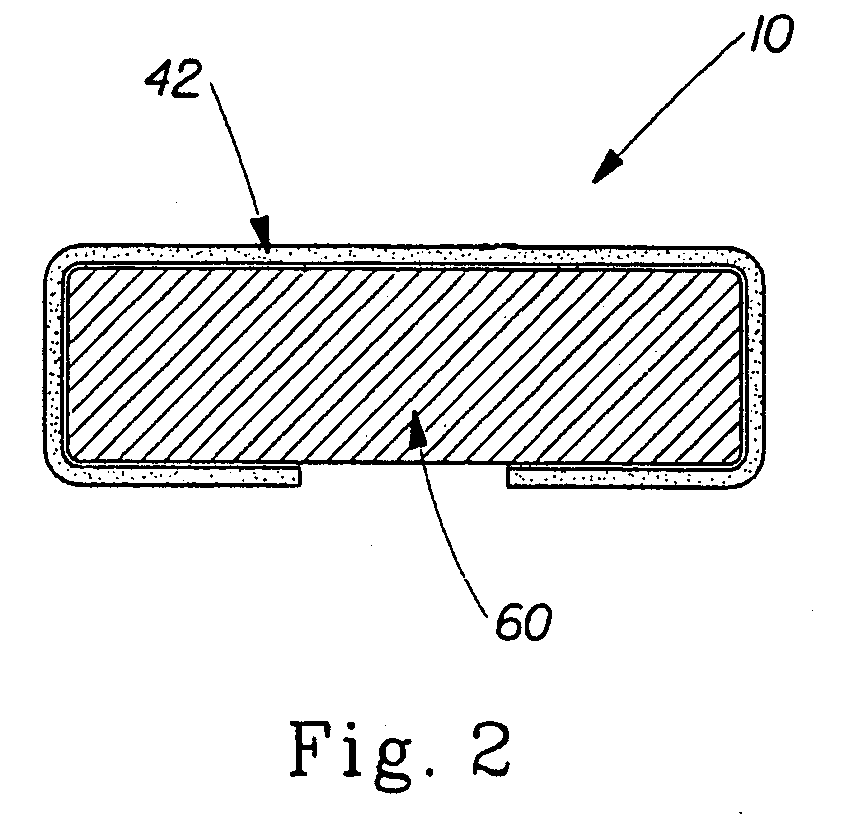Absorbent article comprising a fibrous structure comprising synthetic fibers and a hydrophilizing agent
a technology of hydrophilizing agent and absorbent article, which is applied in the field of absorbent articles, can solve the problems of limiting natural fibers derived from trees, affecting the softness of products, and low stiffness
- Summary
- Abstract
- Description
- Claims
- Application Information
AI Technical Summary
Problems solved by technology
Method used
Image
Examples
example 1
[0092] Four different handsheets using Northern Softwood Kraft and CoPET / PET (isophthalic acid copolymers) fibers with or without different hydrophilizing agents are prepared and tested for their impact on Horizontal Absorptive Capacity (H.A.C.) as determined by the Horizontal Full Sheet (HFS) test method described below.
[0093] All values below are an average of four separate handsheets.
[0094] As shown in the following Table, synthetic fiber addition has a negative impact (˜8% loss) on Horizontal Absorptive Capacity (H.A.C.). Addition of hydrophilizing agents makes the synthetic fibers hydrophilic enough to recover the loss in absorptive capacity.
Basis Weight, g / m2H.A.C. g / gH.A.C. RatioSample A (Base)26.711.551.00Sample B28.310.600.92Sample C27.211.771.02Sample D27.611.681.01[0095] Sample A 100% Northern Softwood Kraft (Control sample with cellulosic fibers only) [0096] Sample B About 70% Northern Softwood Kraft and about 30% CoPET / PET [0097] Sample C About 70% Northern Softwood...
example 2
[0101] A pilot scale Fourdrinier papermaking machine is used in the present example. A 3%, by weight, aqueous slurry of Northern Softwood Kraft (NSK) is made up in a conventional re-pulper. The NSK slurry is refined gently and a 2% solution of a permanent wet strength resin (i.e., Kymene 557LX which is marketed by Hercules Inc., Wilmington, Del.) is added to the NSK stock pipe at a rate of 1%, by weight of the dry fibers. The adsorption of Kymene 557LX to NSK is enhanced by an in-line mixer. A 1% solution of Carboxy Methyl Cellulose (CMC) is added after the in-line mixer at a rate of 0.2%, by weight of the dry fibers, to enhance the dry strength of the fibrous substrate. A 3%, by weight, aqueous slurry of Eucalyptus fibers is made up in a conventional re-pulper.
[0102] The NSK slurry and the Eucalyptus fibers are layered in a head box and deposited onto a Fourdrinier wire as different layers to form an embryonic web. Dewatering occurs through the Foudrinier wire and is assisted by a...
example 3
[0104] A paper towel is made by a method similar to that of Example 2, but replacing 10% by weight of Eucalyptus by 10% by weight of 6 mm in length and about 20 microns in diameter synthetic bicomponent polyester fibers. The polyester fibers as used in this example are available from Fiber Innovation Technology and are designated as T-201. Forty ppm TexCare™ SRN-240 is added to the Eucalyptus-synthetic fiber pulp mixture. The paper towel has about 40 g / m2 basis weight and contains 70% by weight. Northern Softwood Kraft in one layer and a mixture of 20% by weight. Eucalyptus and 10% by weight of the 6 mm long synthetic fibers in the other layer. The resulting paper towel has an absorptive capacity of 26.3 gram / gram. The resulting HRC value for this paper towel is 0.56 g / sec.
PUM
| Property | Measurement | Unit |
|---|---|---|
| contact angle | aaaaa | aaaaa |
| length | aaaaa | aaaaa |
| length | aaaaa | aaaaa |
Abstract
Description
Claims
Application Information
 Login to View More
Login to View More - R&D
- Intellectual Property
- Life Sciences
- Materials
- Tech Scout
- Unparalleled Data Quality
- Higher Quality Content
- 60% Fewer Hallucinations
Browse by: Latest US Patents, China's latest patents, Technical Efficacy Thesaurus, Application Domain, Technology Topic, Popular Technical Reports.
© 2025 PatSnap. All rights reserved.Legal|Privacy policy|Modern Slavery Act Transparency Statement|Sitemap|About US| Contact US: help@patsnap.com



